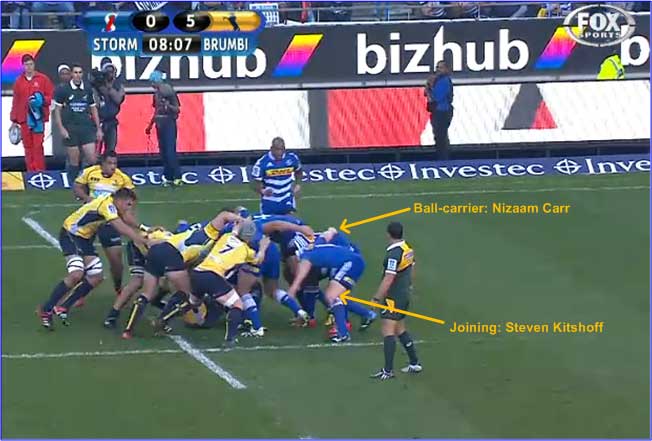We all suspected it might be the case, but the World Rugby refereeing ‘clarifications’ announced last week, which I outlined on Thursday, are evidently going to take some time to take proper effect – if indeed there is any real effect to take.
I was certainly watching closely to see if the areas of re-focus were suddenly refereed completely differently in the Super Rugby qualifying finals.
In reality, it was the same as ever.
To recap, last week’s announcement from World Rugby said that their Laws Representation Group (the illustriously abbreviated LRG) had “considered a number of areas of the game where it had been agreed that law amendments were not required but that current law was to be enforced more stringently by referees, assistant referees, and television match officials”.
Specifically, the so-called crackdown was to deal with high tackles making contact with the head and neck area, challenging players in the air (both Law 10.4 e and i), scrum feeds, and the need to ‘use’ the ball when it becomes available at the back of a stationary scrum (respectively Laws 20.6d, and Law 20.4 e and f).
There was also to be renewed focus on players joining the maul in front of the ball carrier (Law 17.4c), and the requirement that the ‘ripper’ must be properly bound himself (covered by Laws 17.1 and 17.2).
I want to point out a few examples from the weekend around some of these ‘clarifications’, but in doing so I don’t want to criticise ether Chris Pollock or Jaco Peyper, who had excellent games. Both of the qualifying finals were superb, and happily all of the talk since then has been about the rugby itself, and not the officiating.
So onto the examples.
I didn’t see any great benefits to be had from the re-focus on challenging players in the air, and I can’t recall a specific example from either game where the re-focus forced a penalty. There were, however, a few examples of attacking the head and neck area.

In the three examples above, the infringement is pretty clear.
Looking left to right, the first example shows Highlanders flanker Elliot Dixon pulling off a decent impression of what the NRL refer to as a ‘crusher tackle’. In the second, Chiefs prop Ben Tameifuna is attempting to dislodge Highlander Alex Ainley’s head – and the rest of his body, presumably – from the maul. In the third example, Stormers centre Damien de Allende is about to clean out Brumbies flanker David Pocock.
Of these three, only Tameifuna was penalised, and referee Pollock could be heard explaining, “Ben – off the head and neck, please.”
The Dixon tackle on Chiefs fullback Damian McKenzie wasn’t pulled up at all, and the de Allende cleanout on Pocock came after the Brumbies had already been given a penalty advantage from the ruck before. Though his shoulder did hit Pocock’s back, the first contact was the forearm to the head and neck. To his credit, de Allende could be seen apologising to Pocock when the penalty was given.
If the crackdown is to be believed, both should have been penalties, and the Brumbies might have derived greater advantage from where Pocock was cleaned out.
But neither were pulled up, and there were probably dozens of other like these across the weekend. As there has been all year. There was no way they were all going to be pulled up on the first weekend of the crackdown.
Onto joining the maul in front of the ball carrier. Again, there were numerous examples, but the one I’ve picked shows Stormers prop Steven Kitshoff joining the maul alongside Nizaam Carr.

I mentioned last week that players were operating under the direction that as long as they got a touch – rather than actually bind – on the ball carrier, they could then go forward of the ball, and I wondered if these ‘clarifications’ would make any difference.
Certainly there was much written how the re-focus on not allowing players to join in front of the ball-carrier was going to spell the end of the Brumbies’ try-scoring chances; in reality all teams do it, and all teams did it again on the weekend.
In the example above, Carr has only just bound onto the maul himself as Kitshoff arrives, and as I expected, he got a touch on Carr’s back – he’s certainly not yet bound in this image, by the letter of the law – and moved ahead of the ball to bind onto the players in front of him. Play on it was, and play on, it seems. No evident change from what we’ve been seeing all season.
To scrum feeds, and seriously, don’t make me laugh.

The first example, the Chiefs’ Brad Weber, came in or around the 13th minute, while the second, the Stormers’ replacement scrummy Louis Schreuder, was in the 77th minute.
Note both players are on the opposite side of the scrum to the referee, and that both referees are standing upright; they’re not looking into the tunnel.
As a former scrumhalf, I need to give Weber great credit. His feet are square, his shoulders are square, and as far as Chris Pollock can see, this is all going wonderful. The feed was… straight-ish. It certainly falls into the same categories as the “not credible scrum feed” examples in the World Rugby explanatory videos.
Schreuder’s had me genuinely laughing. It’s about as bad as it gets, and this was the scrum in which the Brumbies somehow pulled a tighthead from despite only packing with seven men late in the game. Hello, Mr assistant referee, are you watching?
Again, let me reiterate that none of this is to slight Pollock or Peyper.
However, it is clear that we have a way to go if World Rugby’s desire for “reinforced consistency of application among match officials” is to be realised before the Rugby World Cup in September.
































































































